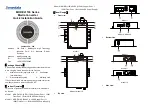
11
Whilst the DAC-10 / DAC-10 DSD will sound superb from the moment it is switched on, due to
the nature of valves, it’s sound will improve even further as it warms up. After 20 minutes it
will be on song, after approximately 40 minutes it will reach its peak performance.
To maximise the life span of the valves, it is recommended to minimise the number of times
that the unit is switched on and off - e.g. where several listening session may be planned during
the course of the day, it is better to turn the unit on before the first session and only turn it off
at the end of the final session – rather than on and off at the end of each session. Ideally, the
DAC-10 / DAC-10 DSD would be kept switched on.
The DAC-10 / DAC-10 DSD has the power consumption of 58W during normal operation (with
signal connected).
Gain Control
The remote-controlled signal output level (Gain) control is located in the centre of the front
panel. It is designed to match the output level of the DAC-10 / DAC-10 DSD to a wide range of
preamplifiers and integrated amplifiers but can also facilitate direct connection to power
amplifiers.
In most circumstances, when used with a preamplifier or integrated amplifier, the output level
of 2Vrms will be achieved at the 12 o’clock position and pro audio level of 4.2Vrms at 3 o’clock
(approximate).
The remote control unit for the DAC-10 /DAC-10 DSD controls the gain control via RF (Radio
Frequency) and allows up and down gain control from the listening position.
Lock
The Lock indicator will “light up” when the compatible digital signal is detected and the input of
the DAC is synchronised with a digital signal source.
The `Lock` indicator is only used for SPDIF input sources.
The DAC is now ready to operate.
Reset
The DAC-10 / DAC-10 DSD is equipped with an SPDIF `reset` switch (non-latching), located on
the back plate. Occasionally, the digital receiver may not lock onto the signal during the power
up cycle or hot swapping of digital input cables. Should this occur, simply single press and
release the `reset` switch. This will restart the receiver’s automatic ‘signal locking’ procedure.
The reset switch has no function for USB inputs.




































